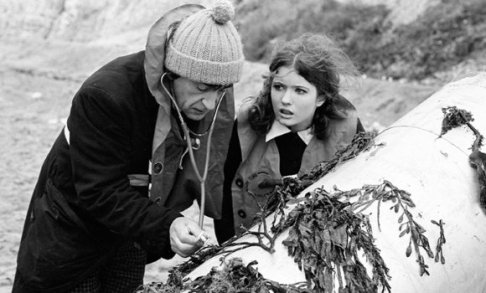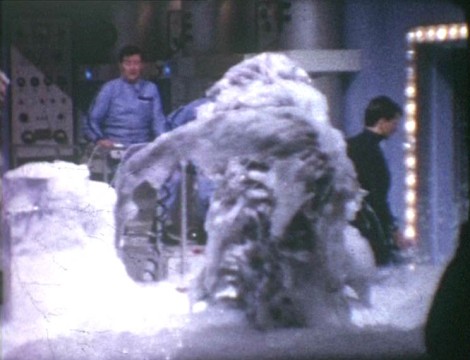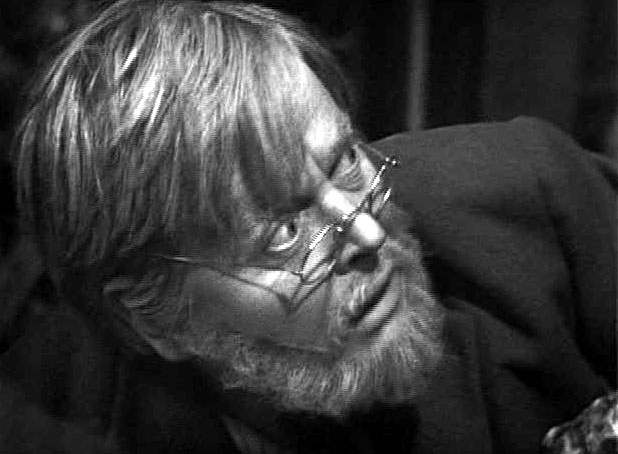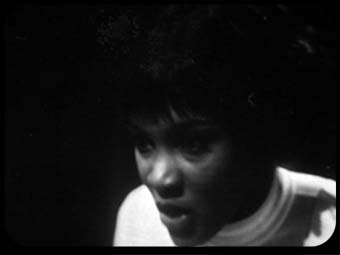Monthly Archives: August 2013
Fury From the Deep – Loose Cannon Reconstructions
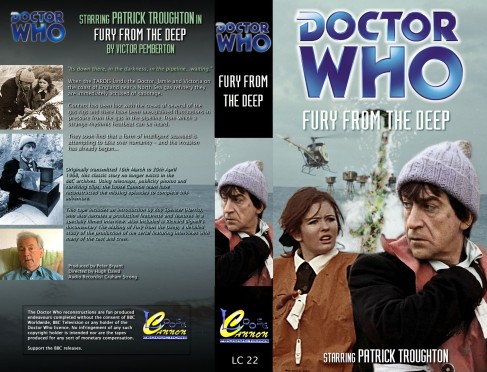 Fury From the Deep is the last Doctor Who story with all of its episodes missing. Only three serials subsequent to this one, The Wheel in Space, The Space Pirates and The Invasion have missing episodes, although the two missing parts of The Invasion have been brilliantly animated by Cosgrove Hall. I’m now on the home run! For the purposes of this marathon I viewed Loose Cannon’s superb reconstructions, links for which appear below.
Fury From the Deep is the last Doctor Who story with all of its episodes missing. Only three serials subsequent to this one, The Wheel in Space, The Space Pirates and The Invasion have missing episodes, although the two missing parts of The Invasion have been brilliantly animated by Cosgrove Hall. I’m now on the home run! For the purposes of this marathon I viewed Loose Cannon’s superb reconstructions, links for which appear below.
Loose Cannon’s Fury From the Deep, Episode 1 Part 1
Loose Cannon’s Fury From the Deep, Episode 1 Part 2
Loose Cannon’s Fury From the Deep, Episode 2 Part 1
Loose Cannon’s Fury From the Deep, Episode 2 Part 2
Loose Cannon’s Fury From the Deep, Episode 3 Part 1
Loose Cannon’s Fury From the Deep, Episode 3 Part 2
Loose Cannon’s Fury From the Deep, Episode 4 Part 1
Loose Cannon’s Fury From the Deep, Episode 4 Part 2
Loose Cannon’s Fury From the Deep, Episode 5 Part 1
Loose Cannon’s Fury From the Deep, Episode 5 Part 2
Loose Cannon’s Fury From the Deep, Episode 6 Part 1
Loose Cannon’s Fury From the Deep, Episode 6 Part 2
Fury From the Deep
Commentators have frequently, and with due cause, taken umbrage at the portrayal of women, particularly companions, in Doctor Who. Renown for her lung capacity as much as her acting ability, Deborah Watling’s characterization of the Victorian era companion, Victoria, has been the subject of more than its fair share of criticism. Akin to some feminist Biblical commentators who trawl to Bible to inspire fresh pro-women interpretations, so Victoria’s well known and frequently decried propensity to scream is being re-interpreted and hailed by me as a new foundation for women in Doctor Who. “How can it be so?” you may ask as your casually scratch your heads. Well, precisely because in The Fury From the Deep, her last serial, Victoria’s screams are transformed into perhaps the most lethal weapon that the Doctor has ever used against ravaging monsters.
Whereas the kindly Sensorites were repelled by bright light, in The Fury From the Deep high pitched noise is the seaweeds’ weakness. Victoria’s scream was the anecdote needed to cure the residents of the base of their infestation of seaweed. Having realized the link between noise and the retreat of the seaweed, the Doctor records Victoria’s screams on a tape recorder and then broadcasts them down the gas rig’s pipe system. Amplified to a frightening level, the distorted din of Victoria’s screeches caused the weed’s rapid retreat. Victory was achieved not by brawn or muscle, but merely by the harnessing of fear.
Whilst a desire to depart from the TARDIS was verbalized from time to time by Ian and Barbara, Victoria is the only companion since the teachers to repeatedly express frustration at life in the TARDIS. Admittedly Steven barged out of the TARDIS in anger at the Doctor’s egocentrism at the end of The Massacre, although he was decidedly quick to return. Commencing in the third episode of The Fury From the Deep, Victoria displays a real sense of unease with the near constant battles that the TARDIS crew are confronted by. Counselled by Jamie, who is clearly distressed at the thought of her leaving, Victoria’s anxiety deepens as the serial progresses. At one point she says to Jamie “Why can’t we go somewhere pleasant? Where there’s no fighting, just peace and happiness?” When Victoria asked the Doctor why they always land in trouble his response was less than satisfactory. “Well, Victoria, it’s the spice of life, my dear”, the Doctor responded. Danger was not a spice that Victoria cared to have added to her dish of life.
One wonders how an oil installation in the middle of the sea, with a couple whom she’d met only days before, could be preferable to the security which the Doctor and Jamie provided Victoria. Unfortunately Victoria had never been afforded the opportunity to properly grieve the death of her father at the hands of the Daleks. She clearly missed her father, as evidenced by her tender conversation with the Doctor in The Tomb of the Cybermen. If Victoria’s tenure was written today then I wouldn’t be surprised if an examination of Post Traumatic Stress Disorder would surface. Victoria’s adventures with the Doctor would have greatly exacerbated her PTSD symptoms which may well have included reliving her father’s death, amongst other things. Her departure, when considered in the light of her encounter with the Daleks, is a great deal more understandable.

Whoever could have imagined that the Laurel and Hardy of gas repairmen, Oak and Quill, could be so menacing
After the hasty retreats of Vicki, Dodo and Steven it was a relief to see a companion departure that was not rushed and actually pre-empted three episodes before she left. As you may well recall, Vicki stayed in Troy with Troilus, whom she had met but a day or two beforehand (The Myth Makers); Dodo disappeared to the country for recuperation midway through The War Machines; and Steven elected to remain behind to facilitate peace between the Elders and Savages in The Savages.
The Fury From the Deep heralds the Doctor’s first use of his now ubiquitous, get out of gaol free card, the sonic screwdriver. Confronted by a black metal box fastened to a pipe on the beach in episode one, the Doctor waves his magic wand and miraculously the screws unwind themselves. The Doctor had obviously never used the sonic screwdriver in Jamie’s presence before because the kilted lad innocently asks what it is. It “never fails”, the Doctor says of the tool which works on “sound waves”. I wonder if the writer, Victor Pemberton, still receives financial compensation every time it’s used?

The sonic screwdriver makes its debut in this story. The Second Doctor’s sonic was a basic model and looked surprisingly like a pen torch.
The sonic screwdriver is not without its critics. John Nathan-Turner, the producer of Doctor Who from 1980 to 1989, is frequently quoted as having said that “When the writers rely on it to get out of every tight situation, there’s no suspense, no variety, no drama”. The sonic screwdriver was destroyed in the Season 19 episode The Visitation (1982) and would not be seen again in Classic Series Who. That the Fifth Doctor did not use a sonic screwdriver was remarked upon in Time Crash, the mini episode featuring the Fifth and Tenth Doctors in 2007. The Tenth Doctor jokes to the Fifth Doctor that he “liked to go hand free, didn’t you, like hey, I’m the Doctor. I can save the universe using a kettle and some string. And look at me, I’m wearing a vegetable”.
The Fifth and Tenth Doctors meet in Time Crash (2007)
Mr Quill and Mr Oak, the menacing gas service men, are brilliant in The Fury From the Deep. Thanks to the ever vigilant Australian Censorship Board, Quill and Oak have the distinction of sharing the longest cut scene in the unfortunate history of missing episodes. Clocking in at 56 seconds, the viewer is treated to their entry into Mrs Harris’s bedroom as she is brushing her hair at a dressing table. Having tricked their way into her home by pretending to be servicing the stove, Oak and Quill open their mouths and omit a toxic gas which renders Mrs Harris unconscious. To achieve the effect of blackened mouths the actors John Gill (Oak) and Bill Burridge (Quill) ate charcoal biscuits before the scene. I doubt that they would have been keen to do that again! The silent menacing of Oak and Quill is perhaps one of Doctor Who’s finest examples of using the ordinary to produce terror. So too is Mrs Harris’s walk into the sea in which she is seemingly committing suicide. The “Yeti on the loo” effect is at its best in this serial. Even things as innocuous as seaweed, foam and gas workers are the source of nightmares.
Watch the Oak and Quill clip from 0:36 onwards. I love the note that accompanies that clip – “Don’t watch if in Australia”!
When the TARDIS landed in the sea before a white cliffed beach the Doctor was certain that the crew had landed in England. Jamie responded with suspicion, “Aye, it’s always England. I think by the hammering the TARDIS has got, you’ve gone and spiked it”. As a Scot, the TARDIS’s propensity to constantly land in England probably annoyed Jamie immensely. It would not surprise me, however, if the writer Victor Pemberton was having a dig at the stereotypes that had built up around the programme. Together with Victoria’s screams, it’s refreshing that the programme could laugh at itself. Laughing at Doctor Who may well be warranted when we view the next serial, Season Five’s last offering, The Wheel in Space. Please join me as I continue my journey through Doctor Who.

Fury from the Deep was originally broadcast in the UK between 16 March and 20 April 1968. It is the last Doctor Who serial with all its episodes missing from the BBC Archives.
Vivien Fleming
©Vivien Fleming, 2013.
The Tenth Planet – DVD Contents and Cover Announced
 The DVD Contents and Cover of the forthcoming The Tenth Planet release have been announced. Due for Australian and New Zealand release on 20 November 2013, the DVD includes a number of fascinating special features not the least of which is a television interview with the First Doctor, William Hartnell. Other features include a profile of Anneke Wills’ portrayal of the companion Polly, and Peter Purves, Frazer Hines and Mark Strickson reminiscing about their time as companions of the First, Second and Fifth Doctors. Full details of the two Disc DVD contents can be found at Doctor Who.tv here.
The DVD Contents and Cover of the forthcoming The Tenth Planet release have been announced. Due for Australian and New Zealand release on 20 November 2013, the DVD includes a number of fascinating special features not the least of which is a television interview with the First Doctor, William Hartnell. Other features include a profile of Anneke Wills’ portrayal of the companion Polly, and Peter Purves, Frazer Hines and Mark Strickson reminiscing about their time as companions of the First, Second and Fifth Doctors. Full details of the two Disc DVD contents can be found at Doctor Who.tv here.
While you eagerly await The Tenth Planet’s release enjoy this exclusive animation of the First Doctor’s regeneration. The missing episode four of The Tenth Planet has been fully animated and will be included in this release.
The First Doctor’s regeneration in The Tenth Planet.
Vivien Fleming
Fury From the Deep – The Making of Fury From the Deep
The next serial in my marathon is the penultimate for Season Five, Fury From the Deep. I’d rather like, however, to view the long awaited Ice Warriors before it. I’m hoping that The Ice Warriors DVD, which is released today, will materialize in my letterbox sometime this afternoon. It was supposedly posted from Melbourne on Monday, so here’s hoping that Australia Post adheres to its estimated delivery schedules!
Killing time in the interim, I’ve viewed Richard Bignell’s fascinating 1999 amateur documentary, The Making of Fury From the Deep. Running for 50 minutes, the documentary is resplendent with cast and crew interviews and interesting anecdotes from the filming. It comes highly recommended and can be viewed at the YouTube link below. Enjoy!
Richard Bignell’s The Making of Fury From the Deep.
Vivien Fleming
The Web of Fear – Loose Cannon Reconstructions
 Only episode one of The Web of Fear is held in the BBC Archives and has been released on the triple DVD set, Lost in Time. For the purposes of this marathon I viewed Loose Cannon’s reconstructions of episodes two through to six, links to which are provided below.
Only episode one of The Web of Fear is held in the BBC Archives and has been released on the triple DVD set, Lost in Time. For the purposes of this marathon I viewed Loose Cannon’s reconstructions of episodes two through to six, links to which are provided below.
Loose Cannon’s The Web of Fear, Episode 2 Part 1
Loose Cannon’s The Web of Fear, Episode 2 Part 2
Loose Cannon’s The Web of Fear, Episode 3 Part 1
Loose Cannon’s The Web of Fear, Episode 3 Part 2
Loose Cannon’s The Web of Fear, Episode 4 Part 1
Loose Cannon’s The Web of Fear, Episode 4 Part 2
Loose Cannon’s The Web of Fear, Episode 5 Part 1
Loose Cannon’s The Web of Fear, Episode 5 Part 2
Loose Cannon’s The Web of Fear, Episode 6 Part 1
Loose Cannon’s The Web of Fear, Episode 6 Part 2
The Web of Fear
Alistair Gordon Lethbridge-Stewart began his television career in Doctor Who as a Colonel in The Web of Fear and ended it, more than 40 years later, with a knighthood in the Sarah Jane Adventures serial Enemy of the Bane. In the interim the Brigadier, as he was most frequently and affectionately known, appeared in 103 TV episodes of Classic Series Doctor Who¸ the 1993 30th Anniversary Special Dimensions in Time, and two episodes of the Sarah Jane Adventures (2008). The character’s death was acknowledged in the Series 6 episode The Wedding of River Song (2011). The Brigadier also appeared as a character in countless audio dramas, books, cartoons and short stories right up until the actor Nicholas Courtney’s death in February 2011.

The Doctor first met Colonel Lethbridge-Stewart in less than perfect circumstances in The Web of Fear (1968)
Lethbridge-Stewart appeared alongside the Second, Third, Fourth, Fifth and Seventh Doctors in serials and with the Sixth Doctor in Dimensions in Time. Nicholas Courtney, however, had the distinction of also appearing as Bret Vyon in the first four episodes of the First Doctor’s serial, The Daleks’ Master Plan. Interestingly, Courtney’s first and last appearances in Classic Series Doctor Who were alongside fellow actor Jean Marsh. Marsh had played Courtney’s sister, Sara Kingdom, in The Daleks’ Master Plan and was Morgaine in 1989’s Battlefield. To tangle the interweaving web of Doctor Who even further, Marsh had been married to Jon Pertwee, the Third Doctor, between 1955 and 1960.

Brigadier Sir Alastair Gordon Lethbridge-Stewart in the Sarah Jane Adventures serial, Enemy of the Bane (2008)
Brigadier Sir Alistair Gordon Lethbridge-Stewart was the longest running recurring human character in Doctor Who by a country mile. The only villainous characters of greater longevity have been the Daleks, who first appeared in 1963, the Cybermen (1966), The Ice Warriors (1967) and quite ironically for the purposes of this review, the Great Intelligence (1967). And to think that contract to appear as Colonel Lethbridge-Stewart was only four weeks long!
The Eleventh Doctor learns of the Brigadier’s death in The Wedding of River Song
Aside from the creation of the iconic Lethbridge-Stewart, one would be hard pressed to find another Doctor Who story that had such a long term influence on the series than The Web of Fear. As a classic example of the “base under siege” genre, it was the first to be set in present day London. Transferring the previously Himalayan bound Yeti to the London Underground provided both a contemporary and identifiable point of reference for viewers. The sense of terror was greatly amplified when monsters were lurking in the tunnels and tube stations that most viewers knew so well. Incidentally, one of the actors in the Yeti suits was none other than John Levene, who would go on to portray another long time recurring character, UNIT’s Sergeant Benton.
The Second Doctor’s co-operation with the military in The Web of Fear would resurface in Season Six’s The Invasion, in which both Lethbridge-Stewart and Benton were members of the newly established United Nations Intelligence Taskforce (UNIT). The Invasion was the template for the Third Doctor’s earthbound exile in Seasons Seven and beyond. But more about that when I review The Invasion.
The appearance of the Yeti in The Abominable Snowmen, and its sequel, The Web of Fear, propelled them to iconic status. As a consequence of the writers, Henry Lincoln and Mervyn Haisman’s, falling out with the Doctor Who production team the Yeti would only appear again briefly in the 1983 Twentieth Anniversary Special, The Five Doctors. The Yeti’s short screen time had little effect on the creatures’ iconic status. Although never appearing alongside the Yeti on screen, Jon Pertwee is fondly remembered for his oft quoted phrase, “Yeti on the loo in Tooting Bec”. What Pertwee was referring to was the direction that Doctor Who had taken during the Third Doctor’s earthbound tenure. The Doctor was confronting the monsters, not on an alien planet, but in the viewers’ own backyards, or toilets, or under their city …. Akin to the expression, “Behind the Sofa”, “Yeti on the loo” quickly entered the Who vocabulary.
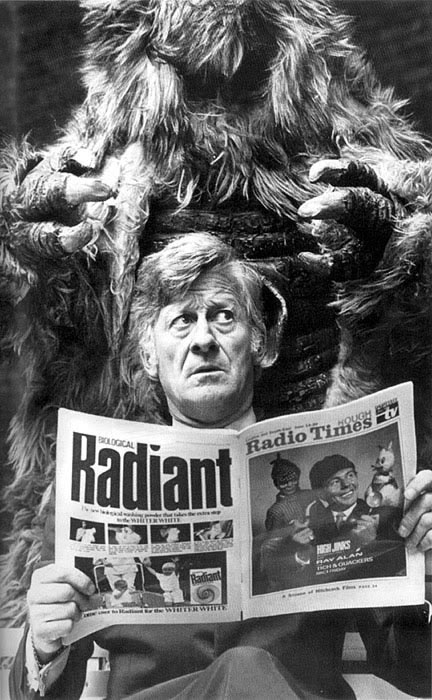
Reading a paper in the loo is a perfectly reasonable thing to do. But did the Third Doctor anticipate meeting a Yeti in the loo?
This “Yeti on the loo” in-joke was most probably lost on a great many New Series viewers to part three of Pond Life, the prelude mini-adventures to Series Seven. The pun was much more than just the play on words of “Ood” and “loo”, and was most certainly a shout-out to Classic Series Who. Give a thought to the late Jon Pertwee as you watch Rory and Amy’s startled responses to the Ood in their bathroom.
Rory and Amy are confronted by an unexpected guest in Part 3 of Pond Life.
Before we leave the Yeti, The Web of Fear was the last serial to feature the sublime composition by British Composer, Martin Slavin, entitled Space Adventure. Ordinarily the Cybermen’s theme, it provided a superb backdrop for their first three stories, The Tenth Planet, The Moonbase and The Tomb of the Cybermen. In its last appearance in Who this composition accompanied the Yeti in Covent Garden.
The Web of Fear is not without its failings. There is an unfortunate negative Jewish stereotype in episode one in the form of Julius Silverstein, a wealthy artefact collector and business person who runs his own museum. Having acquired a deactivated Yeti from Edward Travers, he refused to return it after being advised that the Yeti’s control sphere had been reactivated and disappeared. The consequence of this belligerence was Silverstein’s own death at the hands of the reactivated Yeti. When Terrance Dicks novelized the serial as Doctor Who and the Web of Fear in 1976 the character’s name was changed to Emil Julius in an attempt to avoid the negative stereotype.
As equally offensive, but rarely mentioned, example of racism is the characterization of Driver Evans, a Welsh officer of the British Army and a member of Lethbridge-Stewart’s team. Evans is portrayed as unintelligent and cowardly, and he clearly wants to dessert from the Army. Had there been more than one Welsh Army officer in the serial then this Cymrophobia (anti-Welsh sentiment) could have been averted by presenting the other character(s) as courageous. Evidently Terrance Dicks was also concerned by this Cymrophobia and had Lethbridge-Stewart state that ordinarily the Welsh are good soldiers.
The unfortunate stereotyping of the age aside, The Web of Fear is a tremendously suspenseful serial beautifully directed by Douglas Camfield. High up on many Who fans lists of “most wanted” missing serials, The Web of Fear’s influence on the future of Doctor Who could never have been imagined when its episodes were junked. Only episode one remains in the BBC Archives, which is one more than the next serial in my marathon, Fury From the Deep. Join me for my next review as I examine how Australian film censorship has given us a tantalizing glimpse of this long lost story.

Episode 1 of The Web of Fear is held in the BBC Archives and has been released on the triple DVD set, Lost in Time. The Web of Fear was originally broadcast in the UK between 3 February and 9 March 1968.
Vivien Fleming
©Vivien Fleming, 2013.
The Enemy of the World – Loose Cannon Reconstructions
Only episode three of The Enemy of the World is held in the BBC Archives. It has been released on the triple DVD set, Lost in Time. For the purposes of this marathon I viewed Loose Cannon’s masterful reconstructions of the remaining five episodes, links to which appear below.
Loose Cannon’s The Enemy of the World, Episode 1 Part 1
Loose Cannon’s The Enemy of the World, Episode 1 Part 2
Loose Cannon’s The Enemy of the World, Episode 2 Part 1
Loose Cannon’s The Enemy of the World, Episode 2 Part 2
Loose Cannon’s The Enemy of the World, Episode 4 Part 1
Loose Cannon’s The Enemy of the World, Episode 4 Part 2
Loose Cannon’s The Enemy of the World, Episode 5 Part 1
Loose Cannon’s The Enemy of the World, Episode 5 Part 2
Loose Cannon’s The Enemy of the World, Episode 6 Part 1
Loose Cannon’s The Enemy of the World, Episode 6 Part 2
The Enemy of the World
Appearing exactly half way through Patrick Troughton’s tenure as the Second Doctor, The Enemy of the World is an oft forgotten gem hidden amidst the monster laden fare of Season Five. With only one of its six episodes held in the BBC Archives, The Enemy of the World is frequently overlooked because the single episode released on Lost in Time is so dissimilar to the other five. When I first watched episode three of Enemy I was knocked out by Reg Lye’s characterization of Griffin the chef. The forthright Australian with the phenomenal panache for black humour explodes from the screen with an eccentric disposition that, despite its quirks, is readily identifiable with. That being said, exactly what it meant and why it was included left me totally confused. Upon re-watching the episode during a viewing of Loose Cannon’s reconstructions, it quickly made sense. Griffin is the audience’s identification in a tale of multi-cultural, worldwide intrigue.
The Enemy of the World is Doctor Who’s first foray into James Bond action style conspiracies for world domination. As Barry Letts’ debut to the series as director, it foreshadows a style which will become quite familiar during Jon Pertwee’s tenure as the Third Doctor. With Letts as Who’s producer, action scenes such as those in the first half of episode one of Enemy of the World will become a great deal more common. The hovercraft and helicopter scenes in Enemy are but a prelude to the chase extravaganzas of 1970’s serials such as episode two of Planet of the Spiders. It’s such a shame that all we have left to gauge the success of these Enemy scenes are telesnaps and the audio.
What differentiates The Enemy of the World most from the other Season Five serials is that the only monster is a human. Patrick Troughton was afforded the opportunity to play two characters in the serial with the second being perhaps the most sinister of all Who villains, the dictator Salamander. A Mexican national, Salamander is perceived as a hero to a world confronted by the ravages of war and world famine. He invented the Suncatcher Mk VII, a device which collects and stores concentrated sun-rays. In a film clip showed to the Doctor by Giles Kent, an Australian whom the audience initially believes to be a principled opponent of Salamander, the impression Victoria receives is that the Mexican is indeed a generous public benefactor. Speaking of the successes of the Sun Conservation establishment at Kanowa, in the Australasian zone, Salamander states that his Sun Catcher has allowed the sun’s rays to be shone upon those areas most needing them. Wheat is growing on the Canadian plains and the Ukraine is the grain field of the planet. Corn is ripening on the Dnieper River where 10,000 robot harvesters are gathering fifty million tons of flour. The impression given is that Salamander is the world’s saviour from starvation.
The philanthropic ventures of Salamander are, however, a veil behind which he hides his plans for world-domination. Unbeknownst to all but Giles, Salamander has kept a group of English scientists captive underground for five years. The scientists are under the mistaken belief that a nuclear holocaust has devastated the planet and that it is not yet safe to venture outside. Believing Salamander’s claims that the war is still ongoing, the scientists, by means unknown to the viewers, are creating a series of natural disasters with the intention of thwarting the “enemy”. These supposedly natural disasters, such as a volcano in Hungary, are in effect part of Salamander’s plan to wrest control of all of earth’s regions.
I have to admit that my immediate thought on learning about Salamander’s enslavement of the scientist was the 1993 Australian movie, Bad Boy Bubby. In that film a man is kept captive in a putrid flat by his incestuous mother for 35 years. She claims that the air outside is poisonous and whenever she leaves to collect supplies she dons a gas mask. I wonder if Bad Boy Bubby’s writer, Rolf de Heer, was watching Doctor Who in May 1968?
The exact environmental message that the writer, David Whitaker, is intending to make is a little difficult to discern. Whilst concentrated solar power is perhaps seen as a favourable development, human intervention has devastating effects on the environment. Perhaps an analogy is being made between the deliberate human destruction wrought by the enslaved scientists, and the deterioration suffered by the environment from everyday human activity.
What’s less difficult to ascertain is the anti-corporate and anti-big government messages that Whitaker peddles in The Enemy of the World. In the 21st Century we are used to large scale corporations controlling large segments of the economy. A cursory perusal of the Forbes listing of the World’s Biggest Companies exhibits that six of the top 10 provide banking and financial services, three have oil and gas holdings and one is a conglomerate. Industry was much more local and small-scale in the 1960s, however the consequences of allowing the accumulation of much power into the hands of few was nonetheless appreciated by some.
Similarly, The Enemy of the World evidences a concern for the consequences of big government. In the serial the world is divided into a small number of zones which presumably contain previously independent countries. Zones named in the serial include the Central European, African and Australasian. Travel between zones is undertaken by rockets, with the journey between the Australasian and Central European zones taking only two hours. Transport costs are presumably reasonable and certainly within the means of government and corporation officials. Even without the internet, the world of the near future is much smaller. The dismantling of small nation states has made the possibility of multiple zones being controlled by one person or organization frightfully real. In the decades following the Second World War and Hitler’s conquest for European domination, such fears were well founded.
Imagine for a moment, if you will, that The Enemy of the World was set in our current era. Substitute Bill Gates for Salamander and you may begin to understand the concerns raised. Having established one of the world’s largest corporations, Microsoft, which is currently number 41 in the Forbes listing, Gates is revered by many for his generous philanthropic works. Just imagine that there were some who believed that Gates had an ulterior motive, viz, to take control of the governments of the world. I’m not suggesting that Gates’ philanthropy is anything but wholly virtuous, however the scenario should be sufficient to contextualize Salamander’s motives within a 21st Century schema.
That the serial is set in the near future is only a presumption because nowhere in the script is it specifically stated. As Wood and Miles point out in About Time 2, this question could be easily resolved if episode five was recovered. A close up telesnap of a newspaper shows a masthead, however the photo is not clear enough to enable the date to be read. Given that the recovery of The Enemy of the World is mooted in the current missing episodes rumours, it’s somewhat possible that this question may be answered in the future.
Special Feature – Enemy of the World – Lost Serial
When Salamander was ultimately defeated at the serial’s end by the TARDIS, of all things, I was left somewhat concerned by the Doctor’s inaction. In the fifth Series episode, The Time of Angels, the Doctor saves River Song who, like Salamander (and Katarina before him), was swept out into the vortex. Clearly the Doctor is able to navigate the TARDIS with such precision as to be able to collect persons left floating around in space. Whilst acknowledging that David Whitaker was not Steven Moffat, and the whole concept of the TARDIS as a mid-space rescue vessel had not been dreamed up in 1967, it’s nonetheless disturbing that the Doctor’s stated aim of Salamander facing judicial justice was allowed to dissipate with the blast of air out of the TARDIS.
The Eleventh Doctor saves River Song in The Time of Angels.
May I conclude with a short discussion on casting. The Enemy of the World has the distinction of being the first Doctor Who serial to feature a black female in a speaking part. Carmen Munroe played the role of Fariah, Salamander’s official food taster, a position that reminded me of the First Doctor’s The Romans in which poisoning was perhaps the most common means of homicide. Fariah is one of many well rounded characters which also includes Giles Kent, which was played brilliantly by Australian Bill Kerr, Donald Bruce (Colin Douglas) and Benik, Salamander’s assistant (Milton Johns). Enemy was the first of three appearances by Johns in Doctor Who. Mary Peach, who played the Bond type girl, Astrid, was at the time of filming in the running to be Diana Rigg’s replacement in The Avengers. Finally, I would be remiss to forget Patrick Troughton in his role of the Doctor’s doppelgänger, Salamander.

Episode 3 of The Enemy of the World is held in the BBC Archives and has been released on the triple DVD set, Lost in Time. It was originally broadcast in the UK between 23 December 1967 and 27 January 1968.
Vivien Fleming
©Vivien Fleming, 2013.
REFERENCE:
Tat Wood & Lawrence Miles, About Time. The Unauthorized Guide to Doctor Who 1966-1969 Seasons 4 to 6 Volume 2. Mad Norweigan Press: Illinois, 2010.
The Doctors Revisited Specials on UKTV this Sunday
As part of UKTV’s ongoing presentation of the BBC America produced specials for the 50th Anniversary of Doctor Who, the 30 minute The Doctors Revisited programmes on the Fifth, Sixth, Seventh and Eighth Doctors will be aired in Australia and New Zealand on Sunday 25 August. The four specials, played as a two hour block, will screen at 4:25 p.m. in Australia and 4:40 p.m. in New Zealand. The Eighth Doctor special will in effect be a World Premiere as it will not be shown in the US until 31 August.
Much to the chagrin of British fans of Doctor Who, the BBC has yet to air The Doctors Revisited specials in the UK. Exactly why American and antipodean fans can view them, and not the British, has not been addressed by the BBC. The exclusive preview of the 50th Anniversary trailer at the San Diego Comic-Con in July left a similar bad taste in the mouths of British fans. To date the trailer has not aired in the UK and British fans are understandably disturbed that a select few American fans should be the only people who have seen it.
In anticipation of the screening of The Doctors Revisited specials tomorrow, check out the trailers for them which were originally broadcast on BBC America.
The Doctors Revisited – Peter Davison
The Doctors Revisited – Colin Baker
The Doctors Revisited – Sylvester McCoy
The Doctors Revisited – Paul McGann
Vivien Fleming
